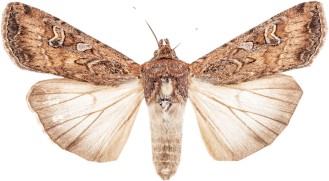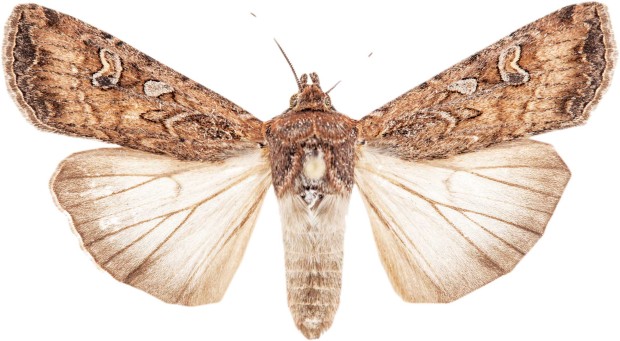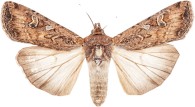 For my middle-of-the-night visits to our home’s smallest room, I’m usually alone. But not lately. Nocturnal face-flapping moths have invaded our home.
For my middle-of-the-night visits to our home’s smallest room, I’m usually alone. But not lately. Nocturnal face-flapping moths have invaded our home.
Sometimes hidden in a hung towel, curtain or closet crack, these fuzzy brown moths seem to be everywhere. Yesterday morning one burst upward at my son from beneath a closed toilet seat lid. Eeaaaagh! Well, at least he was lifting the seat.
These inch-long greyish brown beasts are called miller moths. Their journey begins as eggs laid in turf grass or weedy fields in eastern Colorado and vicinity. Upon hatching in autumn, they emerge as a caterpillar known as the army cutworm, Euxoa auxiliaris. Like a squadron of squishy inchworms, these caterpillars get their name from moving en masse like an “army” does across the landscape. In the fields, miller caterpillars munch on oats, wheat, alfalfa and the like. In the Front Range, they nosh on gardens, grass and broad-leafed weeds. Over winter these creepy crawlers hunker down and feed when necessary. When the ground thaws in spring, they burrow into soil where they undergo metamorphosis. As the weather becomes hotter and drier, they emerge as moths and migrate to mountain meadows in search of wildflowers. En route, some stop by your yard to sip your flowerbed’s nectars. Summers are spent dining on mountain nectar, before returning to mate and lay eggs in the fields again.
Such moths are so plentiful this year that in one room downstairs from my office, they get trapped by the bucketful. Entomologists hypothesize that their greater abundance is due to several weather conditions in northeastern Colorado that were conducive to moth viability. First, the fall’s heavy rains (remember the September floods?) provided more vegetation than normal for newly hatched caterpillars to snack on. Then our snowy winter helped to insulate more of these ground-hugging creatures, so fewer of them froze to death. Lastly a wetter-than-usual spring catalyzed early growth of plants, providing ample food for caterpillars to devour.
But why are they called “miller” moths? It’s their scales. Like a snake or a fish, moth wings are shingled with thousands of tiny scales. Butterflies have them too, which is why scientists classify these creatures as “lepidopterans,” after the Greek words for scale (lepido) and wings (ptera).
 If you were to rub a moth wing between your fingers, these scales would come off and leave a powder-like coating on your skin. Back in the day, this coating reminded people of the flour dust that coated the clothes of grain mill workers. Thus the moths are nicknamed after miller’s flour dust.
If you were to rub a moth wing between your fingers, these scales would come off and leave a powder-like coating on your skin. Back in the day, this coating reminded people of the flour dust that coated the clothes of grain mill workers. Thus the moths are nicknamed after miller’s flour dust.
Although they can be startling to adults and kids alike, miller moths aren’t harmful to humans. In some cases, their carcasses can lead to increases in other harmful pests like carpet beetles, because scavengers eat the carcasses and then multiply. Some miller moths are a nuisance because they excrete secretions that mar light-colored fabrics and walls. Standard cleansers can remove this moth goo.
In the wild, moths are important. They pollinate as they flit from flower to flower in search of nectar. Moths and their caterpillars underpin much of the terrestrial food chain—providing food for birds, bats, frogs, lizards, beetles and spiders. They’re also essential for big critters like Yellowstone grizzlies—who can consume tens of thousands of moths per day.
So what to do if miller moths are bugging you? Insecticides are ineffectual, so your best strategy is prevention. Seal your home’s windows and exterior doorway openings in the spring and turn off white lights at night. Millers are nocturnal so they emerge at dusk and seek shelter at dawn. Most become accidentally trapped in your home while seeking such shelter.
To trap moths you have two options. Fill a cookie sheet or cake pan with soapy water and place it below a desk lamp overnight. The next morning you’ll find a polillo soup of dead millers. Better yet—get your kids to go on a moth hunt in all your home’s dark spaces, as a sort of entomological version of catch-and-release fishing.
Like nature’s own Clif bars, miller moths have more fat and protein per ounce than do game such as elk, deer and bison. They contain a bunch of essential minerals and aren’t poisonous. Thus, moths are eaten all over the world. POWs swear by them as survival food.
A while ago my wife told our daughter that people in other cultures regularly eat insects. Later that afternoon our daughter and her friend were deeply absorbed in some activity out in the yard. Turns out they were eating ants. “Ants taste like salad dressing,” they reported.
I wonder how miller moths taste.
James W. Hagadorn, Ph.D., is a scientist at the Denver Museum of Nature & Science. Suggestions and comments are welcome at jwhagadorn@dmns.org.



0 Comments